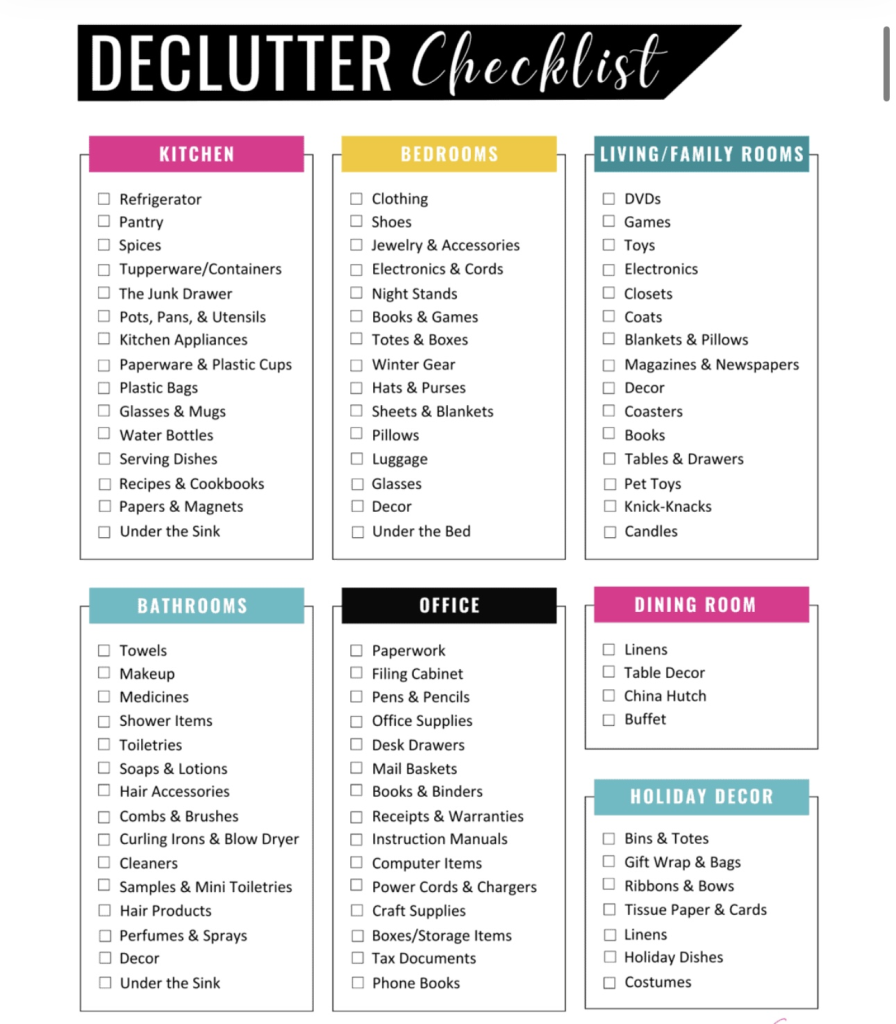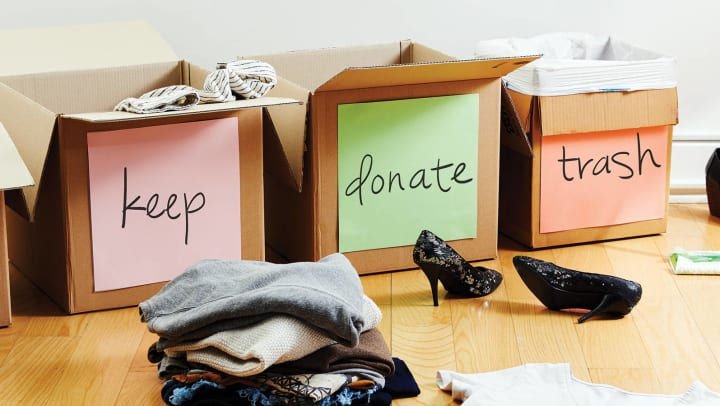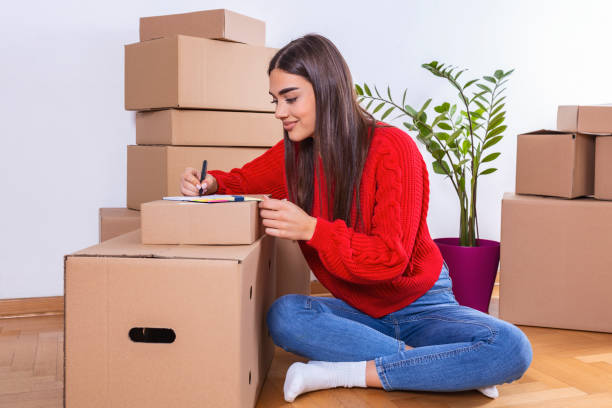Are you ready to reclaim your space for peace of mind? This declutter checklist breaks the process into simple steps to help you achieve clarity, comfort, and a calm home.
Introduction
In a world where everything feels fast-paced and overwhelming, it’s no surprise that our homes can start to feel just as chaotic.
That’s where a good declutter checklist comes in. This isn’t just about tidying up. It’s about creating room to breathe, think, and feel at ease in your space. When you follow a checklist, you’re not just tossing random items. You’re giving yourself permission to reset, focus, and embrace stress-free living tips that truly work.
I’ve found that using a declutter checklist is a powerful home organization guide that brings a sense of order back into my life. It gives structure to the process and makes even the biggest mess feel manageable. So, if you’re looking for a way to feel lighter and more in control, this guide is your starting point in decluttering for peace of mind.
Author’s Note: Checkout our post on Simple Spring Cleaning Tips To Refresh, Declutter, and Deep Clean Your Home With Ease for even more recommendations to keep your environment stress-free!
Why a Declutter Checklist Works Wonders

Let’s be honest, decluttering can feel overwhelming. But a solid checklist breaks everything down into bite-sized tasks, which makes it easier to stay motivated.
I’ve used many checklists over the years, and what I love most is how each small win gives you the energy to keep going.
A step-by-step decluttering plan keeps you focused. It removes the mental load of decision fatigue and lets you approach each task with clarity. Whether you’re doing a full house refresh or just tackling one room, declutter checklists help you see what’s done and what’s next. It’s one of the most effective home organization tips because it shifts decluttering from “where do I even start?” to “look at what I just finished!”
The benefits of decluttering checklists go beyond clean countertops and organized drawers. Effective decluttering can help bring structure to your chaos, reduce mental clutter, and lead to a more intentional lifestyle.
Setting Up Your Declutter Checklist: Getting Started

You might be wondering how to start decluttering. The first thing to do is to take a minute to plan. Creating a declutter checklist isn’t about perfection. It’s about intention.
Walk through your home and jot down areas that need attention. Be honest with yourself. Which spaces feel heavy or overwhelming? Which ones do you avoid?
A strong organizing checklist setup is just like a personal blueprint. It’ll help you see the big picture and then break it into manageable pieces. For example, you might start with the closets this week and the garage next week. The idea is to build momentum without burning out.
Author’s Note: For decluttering specifically targeting your closet checkout our Wardrobe Decluttering Guide where we share closet organization tips and secrets!
Here’s a little tip: prep your mind.
A positive decluttering mindset makes a huge difference. Remind yourself why you’re doing this: more space, more peace, fewer distractions. Grab your favorite cup of tea or coffee and a notebook or app, and create your declutter checklist in a quiet space.
Once it’s written down, the process feels more real and more achievable.
Breaking Down the Process: Room-by-Room Strategies
Trying to declutter your entire home at once is a fast track to frustration. Instead, use a room-by-room decluttering approach. This strategy gives you a sense of progress without feeling overwhelmed.
Every room has its quirks. It might be the outdated decor in your living room, the expired pantry items in your kitchen, the half-empty bottles in your bathrooms, or the forgotten tools in your garage. So when you declutter by room, you treat each room as a mini project, which helps you stay focused and feel accomplished more often.
Use your home cleanup checklist, example shared above, to work through one area at a time. Label tasks like “clear nightstand drawer” or “sort kitchen utensils” to make the process crystal clear. It’s incredibly satisfying to check those off, plus it keeps your motivation high.
With each finished space, you build momentum and reinforce the idea that your home is completely within your control. This way, organizing household items becomes a manageable and fulfilling goal.
Smart Sorting: Deciding What to Keep, Toss, or Donate

One of the biggest decluttering challenges is making decisions. That’s where the “keep toss donate method” comes in. When you pick up an item, ask:
- “Do I use this?”
- “Do I love it?
- “Does it still reflect who I am today?”
This reflective and smart sorting approach can feel tough, but it’s freeing.
Decluttering supports a minimalist lifestyle. It’s less about getting rid of stuff and more about making space for what actually matters. That old toaster you haven’t used in three years? Time to let it go. The mug that makes you smile every morning? That’s a keeper.
Thoughtful declutter decision-making helps cut through emotional clutter (more on this later). And with each item you sort, you not only reduce home clutter, you also feel in control of your space.
Eco-Friendly Decluttering: Sustainable Tips
Decluttering doesn’t have to mean dumping everything in the trash. With the world growing in eco-consciousness, you can experience fulfilling moments by finding new life for old things. Think local donation centers, neighborhood swap groups, or even DIY projects.
Green living is easier than you think, with a little planning, eco-friendly home cleaning becomes second nature. And those green organizing ideas?
They’re good for the planet and great for your home. For example, you can recycle paper, donate clothing, and repurpose storage bins. You’ll clear space and feel good knowing your stuff isn’t just adding to a landfill.
Use these sustainable decluttering tips to guide your choices. When in doubt, remember: recycle and donate clutter whenever you can.
Overcoming Emotional Hurdles During Decluttering

Letting go of stuff can be hard and emotional. Sometimes it’s not about the item itself, but the memories tied to it.
There are times when I hesitate to toss an item because it feels like I’m letting go of a fragment of memory. But the truth is that our memories don’t live in the objects. They live in us.
Author’s Note: Photos are some of the hardest items to let go, which is why we shared this post on Decluttering Sentimental Photos: Quick Tips For Emotional Clarity And Organized Living, hopefully this can bring additional peace.
Practicing mindful decluttering can help you say goodbye with grace and create space for what comes next. You can even take a picture of sentimental items before letting them go. Some other helpful emotional decluttering tips include taking breaks when needed, journaling your thoughts, and being kind to yourself through the process.
Whether it’s tackling sentimental clutter or simply choosing joy over junk, trust yourself to make the right call.
Building a Routine for Long-Term Clutter-Free Living
Decluttering isn’t a one-time event; it’s a lifestyle. Here are some clutter-free habits for you:
- Set a regular declutter maintenance routine, maybe once a week or a month.
- Pair your schedule with a rotating organizing schedule, like monthly fridge cleanouts or seasonal closet edits.
These habits may seem small, but they create a ripple effect over time and lead to big changes. They simplify decision-making, reduce stress, and help you stay on top of what matters.
Ultimately, these sustainable habits make it easier to simplify home life, giving you a clean house, a calmer mind, and more time for what you love.
Tools and Resources to Boost Your Decluttering Journey

Need a little help? You’re not alone. Thankfully, there are so many home organization resources out there to keep you inspired.
- Use declutter apps that give you checklists, reminders, and tips to stay on track.
- You can find free printable checklists online.
- Check out books, blogs, and online videos for organizing tools and decluttering strategies.
- Tap into online groups or local meetups to find encouragement from others on the same journey.
- Practice eco-friendly methods like recycling and repurposing.
There’s something out there for everyone. Explore, test, and find what clicks for you.
Conclusion: Your Next Steps to a Clutter-Free Lifestyle
When you declutter your life, you create space for calm, joy, and ease. Each drawer you sort, each item you donate, brings you closer to a stress-free home that feels like your sanctuary.
Use these powerful home transformation tips as your guide for your home and your mindset.
Your peaceful, clutter-free life is waiting for you. So grab that checklist, take a breath, and start decluttering now!



1 thought on “Declutter Checklist: Room-by-Room Guide to a Lighter Home – Print This – Tips Ideas Inspiration”